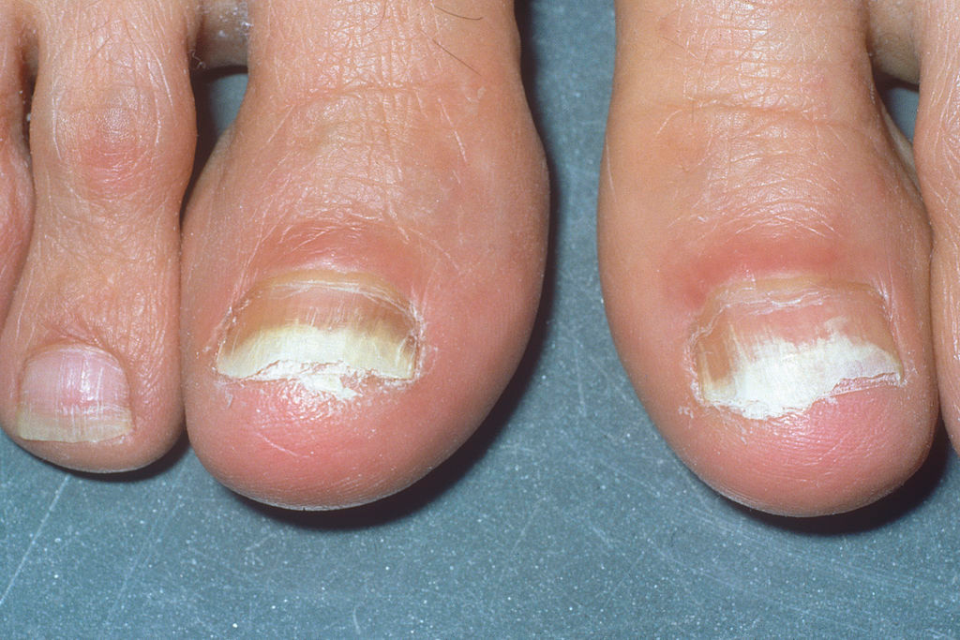The Only Treatments Worth Trying to Get Rid of Gross Toenail Fungus

This article was medically reviewed by Caroline Chang, MD, a board-certified dermatologist and member of the Prevention Medical Review Board, on June 27, 2019.
Your weekend pedicure, post-workout shower at the gym, or barefoot walk around the public pool may have left you with an unwelcome gift: onychomycosis, otherwise known as nail fungus.
Although it starts innocuously enough as a white or yellow spot underneath your finger or toenail, a fungal infection can cause the area to thicken and even crumble as it penetrates deeper and deeper. So naturally, you’ll want to do anything you can to return your nails to their former glory.
“Many people look for a drug-free alternative,” says pharmacologist Joe Graedon, an adjunct assistant professor at the UNC Eshelman School of Pharmacy at Chapel Hill and author of The People’s Pharmacy.
The thing is, there are a lot of so-called natural remedies for toenail fungus out there—and not all of them actually work. Here's everything you need to know about how toenail fungus develops, plus the effective treatments that get rid of it ASAP.
What is toenail fungus, exactly?

Toenail fungus happens when tiny microscopic organisms called fungi get underneath your toenails, causing an infection, according the American Academy of Dermatology (AAD).
Not-so-fun fact: The same fungus that causes jock itch and athlete’s foot can also cause toenail fungus, which can infect your nails and the skin underneath, says Gary Goldenberg, MD, assistant clinical professor of dermatology at the Icahn School of Medicine at Mount Sinai Hospital in New York.
Depending on the type of fungus you’re dealing with, an infection can cause a slew of unpleasant symptoms, including:
Nail discoloration (yellow, brown, green, or white nails)
Debris buildup underneath the nail
Lifting of the nail from the skin
Nail thickening or crumbling
Nail thinning or splitting
Toenail fungus is highly contagious and, if you have a fungal infection on your foot, the fungus can spread to one or more of your nails.
So, what causes toenail fungus?
You can catch toenail fungus in warm, moist places like a pool deck or gym locker rooms. If someone has an infection and walks barefoot on the surface before you, you can easily pick it up, the AAD says.
Having wet nails for long periods of time, like wearing sweaty shoes or soggy boots all day, can also cause toenail fungus.
Certain people are more likely to get toenail fungus than others. You’re more likely to deal with this type of infection if you meet the following criteria:
You live in a hot, humid climate
You have athlete’s foot
You’ve had a nail infection in the past
You have diabetes
You injured a nail recently
You have psoriasis
You have a weakened immune system
You smoke
You spend a lot of time barefoot
You wear tight-fitting, closed toe shoes and you have sweaty feet
You spend a lot of time in water
Ultimately, “anyone can get toenail fungus,” Dr. Goldenberg says. However, he sees it most commonly with athletes, people who go barefoot at the gym or swimming pool, and older patients.
How to treat toenail fungus
Despite what you may hear, covering your infection with nail polish or artificial nails will not get rid of toenail fungus, says the AAD.
There are a few different ways to get rid of toenail fungus, whether you’re looking for home remedies or stronger prescribed treatments. Just know this, per Dr. Goldenberg: “Treating toenail fungus is extremely difficult.”
But the earlier you treat the nail infection, the more likely you are to cure it, explains, Joshua Zeichner, MD, a New York City–based board-certified dermatologist and director of cosmetic and clinical research in dermatology at Mount Sinai Medical Center. “Treatment can take several months, even up to a year, as you need to wait for healthy nail to grow out, which is a slow process,” he says.
If you prefer to go the natural route first, these are the home remedies worth trying—plus, stronger prescription options to ask about if the infection persists. It usually takes three months of treatment to cure a toenail fungal infection.
1. Dab on Vicks VapoRub
Vicks VapoRub contains known antifungal ingredients such as camphor and eucalyptus oil, Graedon says.
In a small study published in the Journal of the American Board of Family Medicine, 83 percent of people who used a cotton swab to apply a small amount of Vicks to an affected nail at least once a day reported improvement, while almost 20 percent got rid of the infection entirely.
How to use it: Follow the study participants’ lead and use a cotton swab to apply a small amount of Vicks to the affected nail once a day. For best results, apply the solution when you have time to let it dry before putting on socks or shoes.
2. Soak in Listerine and white vinegar
The combination of Listerine’s antifungal ingredients (such as thymol and menthol) and vinegar’s acidity makes an inhospitable environment for fungi. “This treatment is effective for green nails which may have what’s called ‘atypical organisms,’” says Dr. Goldenberg. If you have true toenail fungus, it’s less likely to work, though.
How to use it: Combine the two in equal portions and soak your toes in the solution, ideally for 45 to 60 minutes daily.
SHOP LISTERINE SHOP WHITE VINEGAR
3. Apply tea tree oil
Tea tree oil has been used for many years to combat skin conditions, especially fungal infections, says Graedon. Research has shown that the oil might stop and kill fungal infections by breaking down the outer layer of fungal cells and interfering with the way they work. Again, this may not work in all cases.
How to use it: Dab a few drops of tea tree oil on the affected toenails twice a day.
4. Opt for cornmeal
Just a heads up: This is largely anecdotal. “We’ve heard from a few readers that this has gotten rid of fungus,” Graedon says. Due to its antifungal properties, cornmeal has long been used as a way to banish black-spot fungal disease from roses, according to one 2014 review of research.
How to use it: Pour cornmeal into a shallow pan, mix it with water hot enough to dissolve it into a paste, let it cool, and then soak your feet in it for an hour a week.
5. Drop on some oregano oil
Oregano oil contains thymol, a natural compound with antifungal properties. One 2015 study published in BMC Complementary & Alternative Medicine found that thymol reduced the presence of fungus by nearly 90 percent.
How to use it: Put a few drops of oil on your affected nails twice daily.
6. Try topical medications
There are several prescription drugs approved by the Food and Drug Administration (FDA) to treat nail fungus:
Amorolfine
Ciclopirox
Efinaconazole
Tavaborole
In addition, some OTC treatments that contain antifungal agents like tolnaftate and clotrimazole (most commonly used to treat athlete’s foot, ringworm, and other fungal skin infections) can also be worth a try for temporary improvement—but aren’t a permanent fix.
“They are effective in treating athlete’s foot and may help infected nails to some degree, but they are unlikely to clear fungal nail infections because those formulations do not effectively penetrate into the nail itself,” explains Dr. Zeichner. One such topical solution that does sink into the nail? A brush-on treatment called Jublia, an FDA-approved option you can ask your dermatologist about.
How to use it: Each has specific instructions, but you generally apply the medication directly to your nail. The treatment helps keep new fungus out while your nail grows, Dr. Goldenberg says.
7. Ask about antifungal pills
If topical treatment isn’t doing the trick, your doctor may prescribe one of the following antifungal pills:
Fluconazole
Griseofulvin
Itraconazole
Terbinafine
How to use it: Antifungal pills work faster than medicine applied to the nails, the AAD says, but you should still expect a few months of consistent use, per your doctor’s instructions.
Stay updated on the latest science-backed health, fitness, and nutrition news by signing up for the Prevention.com newsletter here. For added fun, follow us on Instagram.
You Might Also Like

